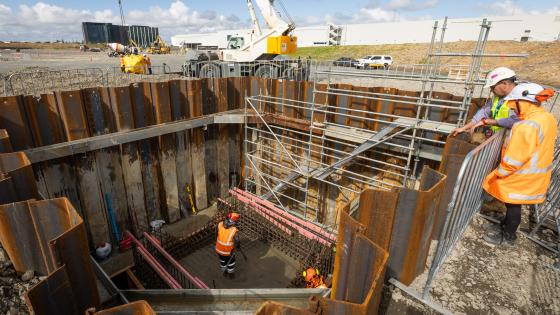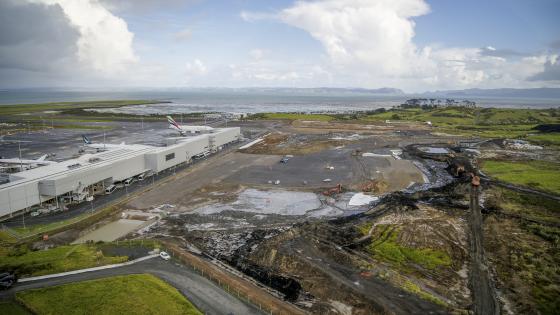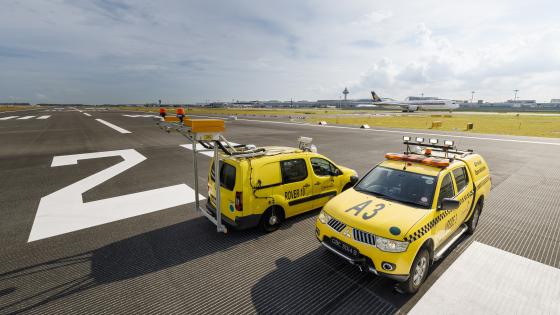Emma Kelly looks at the measures airport operators are taking to ensure it is ‘business as usual’ during even the most severe weather conditions.
With extreme weather events becoming more frequent in the face of climate change and natural disasters a constant threat, airports are preparing their systems and infrastructure for all eventualities.
This year alone has seen airports flooded in virtually every part of the globe, from Exeter in the UK and Frankfurt, Germany, to the airports of New York, and as far south as Auckland, New Zealand.
Many airports, including Amsterdam Schiphol, Hong Kong International and several Japanese hubs, design infrastructure and systems from the outset to cope with the threat of floods, typhoons and earthquakes due to their geographical location. Today, airports not previously impacted by extreme weather events or natural disasters are working to ensure they too are as climate and disaster resilient as they can be.
“Airports need to be proactive and develop their climate change adaptation plan,” said Tom Mockett, director aviation strategy at international aviation consultancy Netherlands Airport Consultants (NACO). NACO has worked with airports worldwide, including Singapore Changi on pre-emptive measures to deal with climate change, and Japan’s Kansai International following typhoon Jebi in 2018, to boost its climate resistance. NACO has also contributed to a global study on the disaster resilience of airports for the Coalition for Disaster Resilient Infrastructure.

HKIA staff distribute water to passengers stranded in the airport during a typhoon
Facing change head on
“We help airports understand their climate exposure, critical assets and operations under threat and how to prioritise adaptation measures,” explained Mockett. “We do this by analysing the threats and mapping them over the climate scenarios, painting a picture of what a ‘no-action’ pathway can look like.”
The result is an adaptation plan which is technically, organisationally and financially feasible for the airport, Mockett told Airports International.
For Singapore Changi, for example, NACO developed a climate change adaptation strategy and roadmap, providing insights into the risks and associated measures the airport can implement to adapt and increase its climate resilience.
The project included climate scenario modelling to determine how the climate might change, combining operational data with weather. NACO worked with stakeholders to map climate risks and the potential impact of a climate event, using its digital tool STAIN to visualise cascading effects. NACO and airport stakeholders developed measures to reduce key risks and increase airport resilience, covering everything from infrastructure to procedures and guidelines. The result was a Climate Adaptation Pathway designed to increase resilience to climate change and reduce potential risks, as well as outlining steps to get there.
NACO’s work with Japan’s Kansai International Airport focused on increasing the protection of critical assets following typhoon Jebi, which was the strongest typhoon to hit the region in 25 years and closed Kansai, which is built on reclaimed, low-lying land, for two weeks due to flooding and significant damage.

An inspection of airport operations at HKIA following Super Typhoon Saola
The Netherlands-based consultancy worked with the airport to anticipate the effects of events on infrastructure and critical assets, developing a detailed mitigation plan to protect critical assets and priority areas, using NACO’s Flood Simulation Tool to recreate the flooding of 2018 and test mitigation options. The result was a phased plan of mitigation measures, designed to reduce airport downtime to just two days if such an event occurs again.
“Prevention is better than cure,” said Mockett, with a Climate Risk Assessment being a good first step towards understanding the effect of climate change, exposure and what’s at risk.
IT and resilience
Airport IT systems should be resilient by design and tested accordingly, he added. Mockett points to the need for cloud solutions, geo-separated data centres and multiple independent pathways for communication and data lines.
IT systems need to support prediction, information and response. In terms of prediction, for example, there is a need for weather monitors, seismic sensors and water level sensors, with information gathered sent to a central information data bus whereby predictive analysis is performed and information distributed.
Airports need technologies that allow them to prepare better and reduce their vulnerability to unexpected weather
When it comes to information, systems are required to distribute information via preferred channels, including SMS, push notification, visual indication and dynamic signage.
Systems are also required to enable decision making and taking action in response to an event. Robust communication systems need to be supported by digital and analogue tools, with Mockett suggesting integration with an artificial intelligence or digital twin operational platform, already running at the airport, but tested for natural incident or disaster effects.
Airports need to reduce their vulnerability to such events as much as possible and new IT solutions are allowing this. “Natural disasters can easily cause damage to on-premises servers and infrastructure, threatening the continuation of service at airports. So, airports need technologies that allow them to prepare better and reduce their vulnerability to unexpected weather, as well as other disruptive events,” said George Richardson, co-founder and CEO of AeroCloud, which provides airport management software solutions.
“That’s why off-premises cloud-based solutions are a much better option for airports in times of crisis. They offer a level of resiliency that fitted hardware just can’t,” he said. AeroCloud’s cloud native platform is underpinned by the global infrastructure of AWS, which means it won’t go down even during natural disasters, according to Richardson. “Airports can therefore rely on our highly sophisticated disaster recovery processes and services to endure during times of crisis,” he added.
Richardson said AeroCloud’s solutions help airports manage operational challenges, including weather issues, from low cloud to hurricanes: “Our cloud-native platform provides real-time information to enable airport staff to understand changing situations quickly and help recover service.”

Staff at the UK’s Exeter Airport clean up after flash floods
Tropical storm Elsa affected airports across Florida in 2021, forcing many to close to inbound flights. AeroCloud client Sarasota Bradenton International Airport (SRQ) was forced to shut as the storm progressed faster than expected. “AeroCloud provided SRQ with visibility of exactly which flights had been delayed, diverted or cancelled through our Gate Management module, enabling the airport to quickly understand the changing situation and help recover services,” Richardson explained.
The airport also used this real-time information to keep passengers updated on flight status and gate changes via AeroCloud’s FIDS screens at the airport, as well as the website and mobile app.
According to Richardson, AeroCloud’s technology can be deployed by airports to enable them to safely manage crowded airports when natural disasters cause delays and disruptions. Its computer vision solution, AeroCloud Optic, anonymously and accurately tracks and manages the flow of passengers from kerb to gate and identifies bottlenecks and issues. Airport operational staff are then notified of issues via their mobile devices, enabling them to quickly resolve any problems.
No stranger to extreme weather
Hong Kong International Airport (HKIA) is no stranger to severe weather events, namely typhoons, and being built on reclaimed land, it is prepared for climate change. “HKIA has been preparing for global climate change, including significant extreme weather events with higher temperatures and regular typhoon-driven high sea levels,” said a spokesperson for the airport, adding that there are a number of controls already in place to ensure the safety and continuity of operations and infrastructure.
HKIA has implemented a comprehensive Weather Preparedness Programme to ensure the airport community is ready for such events, including workshops and drills. The Airport Authority of Hong Kong (AAHK) has developed measures aimed at mitigating the potential risks, adapting to the changing climate and enhancing resilience, the spokesperson says. Operational procedures are in place to deal with extreme weather events, including business continuity, typhoon precautions and media engagement.

October 2023 saw Auckland Airport upgrade the stormwater management system as part of its new airfield development
In terms of critical infrastructure, AAHK conducts inspection and preventative maintenance programmes, carries out regular reviews of enhancement work that may be required, and uses a power supply analyser to monitor anomalies.
The airport has also invested in emergency generators and established specialised teams, including fault response and passenger care teams, while the Airport Emergency Centre is ready for multi-agency co-ordination. Seawall and drainage systems, uninterruptable power supply for essential systems, Internet of Things sensors for real-time storm surge alerts have all been implemented, while climate consideration is integrated into the design for physical and system protection.
Expecting the unexpected
Numerous airports have had recent, first-hand experience of extreme weather. Frankfurt Airport suffered flash flooding during a severe storm in August. Despite not experiencing such an event before, its systems are prepared for local weather-related failures, power failures and IT service failures with comprehensive redundancy plans involving network infrastructure, power and service providers, said Alexander Döhne, Fraport’s head of cybersecurity.
“Some technical IT rooms on the apron were flooded, and network components in these rooms were damaged,” he acknowledged, but added: “Due to implemented redundancy concepts, the IT infrastructure was able to provide the services needed for airport operations, without any outages. Damaged components could be replaced in a matter of hours, since we hold spare parts on the airport.”
Frankfurt Airport prepares for such challenging situations through regular crisis team exercises as part of emergency management. “For IT systems on our campus and in the cloud, there are availability requirements depending on the criticality of the operational processes supported. This includes redundancy concepts for off-site and cloud solutions. Data security is not considered separately, it is part of the specifications and measures,” explained Döhne.
The German airport constantly tests and improves its systems and has planned responses to such situations to ensure the availability of IT systems, said Döhne, in addition to improving passenger communication.
Likewise, the Port Authority of New York and New Jersey (PANYNJ), operator of John F Kennedy International, LaGuardia International and Newark Liberty International airports, regularly tests its processes and procedures to evaluate where improvements are needed, said a Port Authority spokesperson. Those processes and procedures were put to the test in September when extreme storms in New York resulted in flash flooding, including at LaGuardia.
“To ensure that we are prepared for a wide range of potential impacts to our airport operations, the Port Authority and our airport partners hold tabletop exercises including, but not limited to, security exercises, hurricane/snow preparedness exercises and Emergency Operations Centres activation exercises,” the PANYNJ spokesperson explained.

The remote stands at Auckland are especially close to the shores of Manukau Harbour
In late October 2012, Superstorm Sandy severely impacted the New York and New Jersey region, prompting the Port Authority to take action. “Since then, the agency has taken measures reflected in the climate resiliency design guidelines to mitigate risk,” the spokesperson told Airports International.
All airport infrastructure design follows climate resiliency guidelines developed by the Port Authority in conjunction with the New York City Panel on Climate Change. As a result, critical systems are protected. “Critical electrical infrastructure at Port Authority airports is protected by flood walls, elevation of equipment above the 100-year FEMA [US Federal Emergency Management Agency] flood level and located in hardened waterproof enclosures and backed up by emergency generators. All flood mitigation measures have been implemented since Superstorm Sandy and are updated accordingly. Airports are well equipped to manage severe weather events,” the spokesperson said, adding there was no impact on infrastructure or electrical operations during the recent flooding at LaGuardia.
Auckland Airport is located by Manukau Harbour, the second largest natural harbour in New Zealand. The airport experienced its own severe weather event in late January, which resulted in flooding in the international terminal and the temporary suspension of operations. Passengers were requested not to come to the airport, while more than 2,000 international passengers had to stay overnight in the terminal. Less than a month later, the airport saw operations suspended temporarily again due to excessive winds as a result of Cyclone Gabrielle.
“Auckland Airport’s technology systems remained resilient during both of these weather events, and any minor impacts were able to be quickly resolved,” said an airport spokesperson. “The flooding impacted electronics at ground level, including some baggage handling components of the check-in area.” Impacted components were repaired, including fast-tracking replacement, while planned technology upgrades were brought forward.
The airport is currently undertaking the most significant infrastructure upgrade in its history, with major projects under way across transport, terminals and airfield. This included, in October, boosting flood resilience by upgrading its stormwater management system as part of the new airfield development.
“We need to prepare for both the regular rainfall we get in Auckland, but also some of the more extreme deluges that come with climate change like those we experienced earlier this year,” concluded Mary-Liz Tuck, the airport’s chief sustainability and master planning officer.
Seamless collaboration is the fundamental element for safe and smooth airport operations under extreme weather conditions
During Super Typhoon Saola, also in September, Hong Kong International Airport (HKIA) activated its Airport Emergency Centre to co-ordinate all operations and communications. Additional staff were deployed to assist passengers already in the terminal, with restaurants and shops extending their opening hours, while passengers not at the airport were advised to only leave for HKIA once their airline had confirmed their flight.
“Seamless collaboration is the fundamental element for safe and smooth airport operations under extreme weather conditions,” said a HKIA spokesperson. AAHK works closely with the Hong Kong Observatory (HKO) to provide weather forecasts and warnings, while the HKO’s Airport Meteorological Office monitors hazardous weather phenomena in the atmosphere. During typhoon season, when a typhoon is approaching the city, the HKO will alert the general public as well as the airport community. AAHK will hold a special meeting with airport stakeholders to ensure they are well prepared.
During the flooding and cyclone events which impacted Auckland Airport early this year, it used a wide range of communication channels to keep travellers safe and well informed, said a spokesperson. “This included a high presence of airport staff in the terminals to speak to passengers; communicating via the news, media, radio advertising, printed information drops to passengers in the terminal, regular PA announcements, website information and regular social media updates. We also worked with airlines to cascade information to passengers,” the airport spokesperson said.

Changi Airport’s runways are grooved to reduce the danger of aquaplaning and runway excursions during thunderstorms
Further reading: keeping passengers informed
A number of airports have had to put their passenger communication channels to the test recently in light of weather-related events.
The Port Authority of New York and New Jersey has a multi-faceted approach which was implemented when New York was hit by torrential rain and flooding in September, which forced the closure of LaGuardia’s Terminal A.
“There are several vehicles which we use to communicate with passengers, particularly when a situation arises,” a spokesperson told Airports International. “We encourage travellers to sign up for our alerts or follow the respective airport they are travelling to on X [formerly Twitter]. For customers already at the airport at the time of the incident, additional airport staff are deployed to that area to guide passengers and overhead announcements are made and are also posted on digital boards across the terminals,” said the spokesperson. “At our airports, our staff directly communicate with passengers if an evacuation is necessary and our security assists to ensure the safety of passengers. The agency also communicates through its social platforms and digital and broadcast media.”
